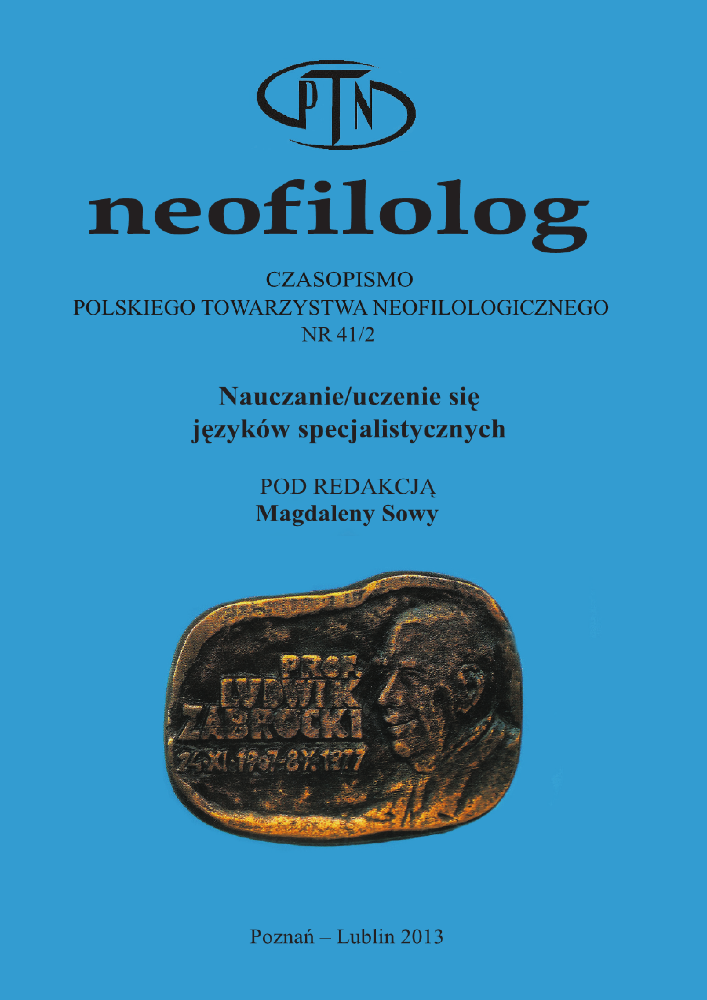Abstrakt
As Arnó-Macià (2012: 89) points out: “Within the integration of technology into language education, special attention needs to be paid to languages for specific purposes (LSP) (…)”. Although a broad range of technologies may support the process of language learning, this paper investigates those technologies which are connected with the computer and Internet use in order to learn a foreign language. A term used to refer to the above-mentioned issue is Computer-Assisted Language Learning (CALL). The paper presents results of a pilot study conducted of students of English for Specific Purposes (ESP) using a questionnaire containing a CALL component. This data collection instrument was especially designed for the purpose of the research. The main aim of the present article is to consider how to measure participants’ competences, attitudes and skills in the area of ICT (Information and Communication Technology).
Bibliografia
Abdelraheem, A. Y. 2004. University faculty members’ context beliefs about technology utilization in teaching. The Turkish Online Journal of Educational Technology 3 (4): 76-84.
Arnó-Macià, E. 2012. The role of technology in teaching languages for specific purposes courses. The Modern Language Journal 96: 89-104.
Brill, J. M., Galloway, C. 2007. Perils and promises: University instructors’ integration of technology in classroom-based practices. British Journal of Educational Technology 38 (1): 95-105.
Brown, J. D. 2001. Using surveys in language programs. Cambridge: Cambridge University Press.
Chen, L.-L. 2004. Pedagogical strategies to increase pre-service teachers’ confidence in computer learning. Educational Technology & Society 7 (3): 50-60.
Cohen, A. D., Oxford, R. L. and Chi, J. C. 2002. “Learning Style Survey: Assessing Your Own Learning Styles” (in) Styles and strategies – based instruction: A teacher’s guide (eds. A. D. Cohen, and S. J. Weaver). Minneapolis, MN: Center of Advanced Research on Language Acquisition, University of Minnesota: 15-21.
Dörnyei, Z. 2003. Questionnaires in Second Language Research: Construction, Administration and Processing. Mahwah, NJ: Lawrence Erlbaum Associates.
Dörnyei, Z. 2005. The Psychology of the Language Learner: Individual Differences in Second Language Acquisition. Mahwah, NJ: Lawrence Erlbaum Associates.
Dörnyei, Z. 2007. Research methods in Applied Linguistics: Quantitative, Qualitative and Mixed Methodologies. Oxford: Oxford University Press.
Dörnyei, Z., Csizér, K. 2012. “How to design and analyze surveys in SLA research?” (in) Research Methods in Second Language Acquisition: A practical Guide (eds. A. Mackey and S. Gass). Malden, MA: Wiley-Blackwell: 74-94.
Fotos, S. and Browne, Ch. M. 2004. New Perspectives on CALL for Second Language Classrooms. Mahwah, NJ: Lawrence Erlbaum Associates.
Gardner, R.C. 1985. Social Psychology and second language learning: The role of attitudes and motivation. London: Edward Arnold.
Gass, A. and Mackey, A. 2008. Data elicitation for second and foreign language research. Mahwah, NJ: Lawrence Erlbaum Associates.
Gruba, P. 2004. “Computer Assisted language Learning” (in) The Handbook of Applied Linguistics. (eds. A. Davies, and C. Elder). Malden, MA: Wiley-Blackwell: 623-648.
Ivankova, N. V. and Creswell, J.W. 2009. “Mixed Methods” (in) Qualitative Research in Applied Linguistics: A practical introduction. (ed. J. Heigham and R. A. Croker). New York: Palgrave MACMILLAN: 135-161.
Kirsch, I., Jamieson, J., Taylor, C. and Eignor, D. 1998. Computer Familiarity among TOEFL Examinees. TOEFL Research report 59, March, 1998. Princeton, NJ: Educational Testing Service.
Lumpe, A. T. and Chambers, E. 2001. Assessing teachers’ context beliefs about technology use. Journal of Research on Technology in Education 34 (1): 93-107.
Luan, W. S., Fung, N. S., Nawawi, M. and Hong, T. S. 2005. Experienced and Inexperienced Internet users among pre-service teachers: Their use and attitudes toward the Internet. Educational Technology & Society 8 (1): 90-103.
Mackey, A. and Gass, S. M. 2005. Second Language Research: Methodology and Design. Mahwah, NJ: Lawrence Erlbaum Associates.
Oxford, R. L. 1990. Language learning strategies: What every teacher should know. New York: Newbury House.
Pallant, J. 2011. SPSS Survival Manual: A step by step guide to data analysis using SPSS. Sydney: Allen & Unwin.
Papanastasiou, E. C. and Angeli, C. 2008. Evaluating the use of ICT in education: psy-chometric properties of the survey of factors affecting teachers teaching with technology (SFA-T3). Educational Technology & Society 11 (1): 69-86.
Richards, K. 2009. “Interviews” (in) Qualitative Research in Applied Linguistics: A practical introduction (eds. J. Heigham and R. A. Croker). New York: Palgrave MACMILLAN: 182-199.
Selim, H. M. 2007. Critical Success Factors for e-learning acceptance: Confirmatory factor models. Computers & Education 49: 396-413.
Sharma, P. and Barrett, B. 2007. Blended learning: Using technology and in and beyond the language classroom. Oxford: Macmillan.
Stockwell, G. 2012. Computer – Assisted Language Learning. Cambridge: Cambridge University Press.
Warschauer, M. 1996. “Computer Assisted Language Learning: an Introduction” (in) Multimedia language teaching (ed. S. Fotos). Tokyo: Logos International: 3-20.
Licencja
Prawa autorskie (c) 1970 Edyta Olejarczuk

Utwór dostępny jest na licencji Creative Commons Uznanie autorstwa – Bez utworów zależnych 4.0 Międzynarodowe.
Przedstawiany utwór (artykuł) upubliczniany jest na podstawie umowy z autorem i na licencji Creative Commons Attribution-NoDerivatives 4.0 International (CC BY-ND 4.0).
Użytkownicy mają obowiązek podania wraz z rozpowszechnionym utworem, informacji o autorstwie, tytule, źródle (odnośniki do oryginalnego utworu, DOI) oraz samej licencji;
- bez tworzenia utworów zależnych,
- utwór musi być zachowany w oryginalnej postaci.
Uniwersytet im. Adama Mickiewicza w Poznaniu zachowuje prawo do czasopisma jako całości (układ, forma graficzna, tytuł, projekt okładki, logo itp.).
